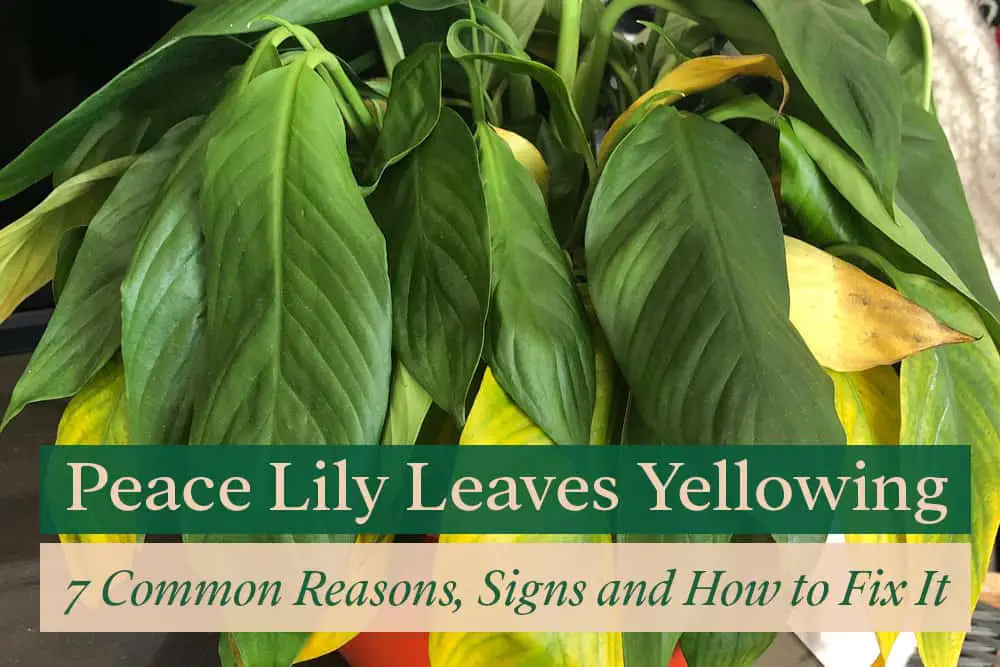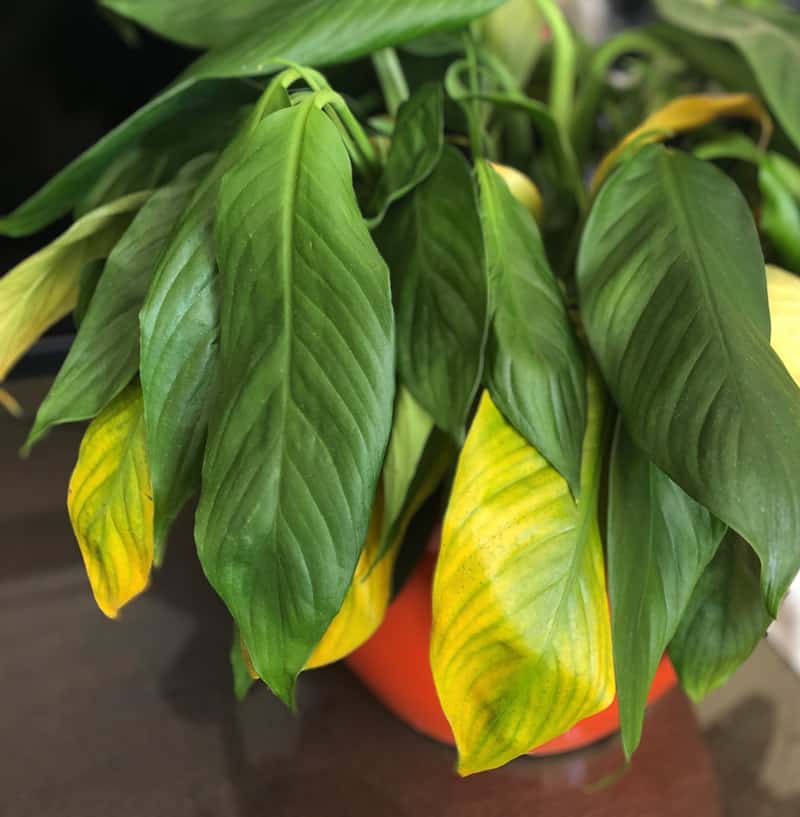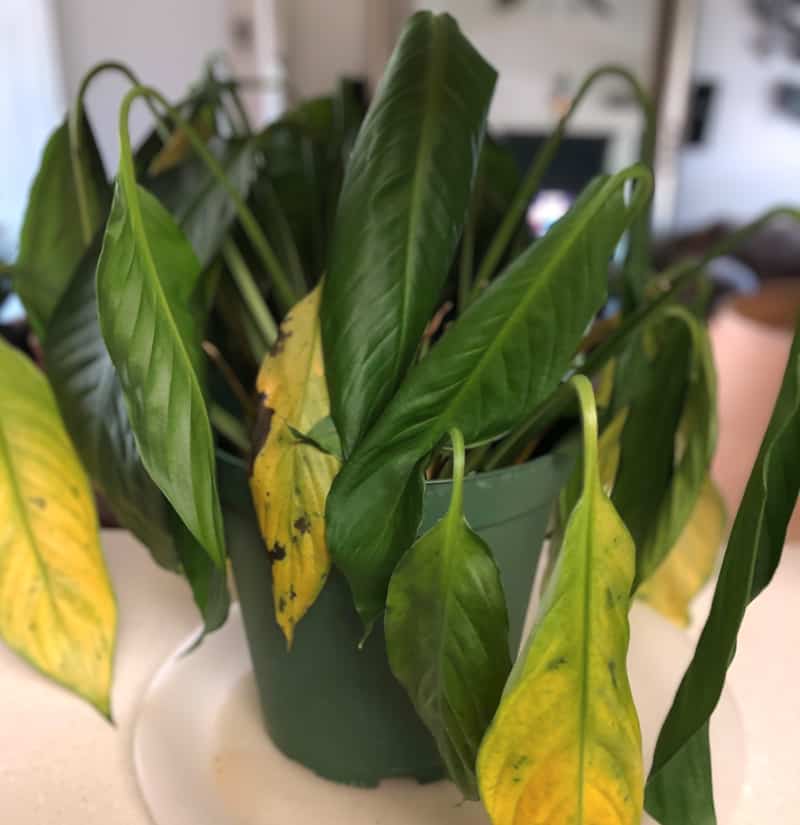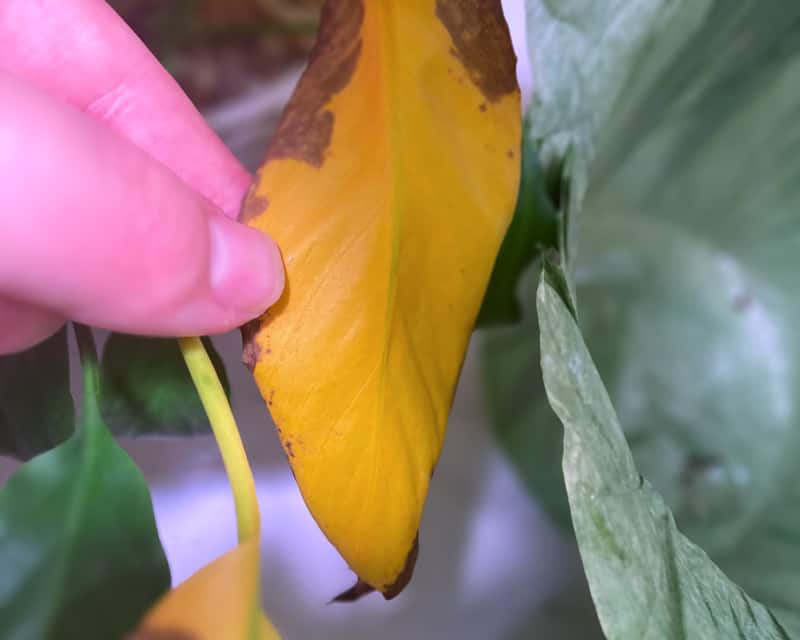
Yellow leaves on a peace lily plant can be a sign of several problems. Understanding the root cause is crucial to fixing the problem.
In general, yellowing Peace Lily leaves are caused by overwatering or not getting enough light. However, there are other possible causes, such as temperature, nutrient deficiencies, pests, and diseases.
As the leaves get older, they will naturally turn yellow and eventually brown before falling off. This is normal and nothing to worry about.
Now, how to know what is really causing the leaves of your Peace Lily to turn yellow? Here are seven reasons, signs, and solutions to help you figure it out:
- Over-watering
- Using hard water
- Inadequate lighting
- Cold temperature stress
- Nutrients deficiency
- Pest infestation
- Natural yellowing of old leaves
7 Reasons For Yellow Leaves On Your Peace Lily Plant
Let’s take a closer look at each of these possible causes.
1. Over-watering
The number one reason for yellow leaves on a Peace Lily is over-watering. This plant doesn’t like wet feet and will start to show signs of stress if the roots are sitting in water for too long.
A waterlogged soil prevents roots from getting the oxygen they need to function properly, inhibiting their ability to absorb water and nutrients required for photosynthesis.
Consequently, your Peace Lily will stop producing new chlorophyll, and the yellow pigments will appear as chlorophyll breaks down. This process is called chlorosis.
Worse of all, overwatering can lead to root rot. If left unchecked, root rot will kill your plant.
Signs of Over-watering in Peace Lily Plants

Yellow leaves are the most common sign of overwatering in peace lilies. However, there are other telltale signs that you can look out for, such as:
- Limp, droopy leaves
- Dark brown spots or edges on the leaves
- Mushy stems
- The soil remains wet and soggy
- Mold or fungi on the soil
- Foul odor from the soil
- Black and mushy roots
If all the roots of your plant have turned black and mushy, it’s too late to save it. However, if you catch the problem early enough, you may be able to salvage your plant.
How to Fix Over-watering in Peace Lily Plants
If you think your plant is overwatered, the first thing you need to do is stop watering it.
Allow the soil to dry out completely between waterings. You can check the moisture level by sticking your finger into the soil up to the second knuckle. If it feels dry, it’s time to water again.
Generally, it takes about 1-2 weeks for the soil to dry out completely. However, this will depend on the size of your pot, the type of soil you’re using, and the temperature and humidity levels of your home.
Next, you need to improve the drainage of your pot. Repotting your plant into a well-draining potting mix is a good idea. Mix perlite or pine bark into the potting mix to improve drainage.
Also, make sure you have a drainage hole in the bottom of your pot. If you don’t have one, water will just sit in the bottom of the pot and lead to root rot.
Lastly, empty any water that’s collected in the saucer under the pot after watering.
Also read: Watering Peace Lily Plants: 9 Essential Tips & How Often to Do it
2. Using hard water
Chlorine and Fluoride are often added to municipal water supplies to kill bacteria and prevent tooth decay. However, these chemicals can be harmful to your plants.
When you water your Peace Lily with chlorinated or fluoridated water, the chemicals will build up in the soil over time and start to poison your plant.
These minerals will inhibit photosynthesis and prevent your plant from taking up vital nutrients, leading to chlorosis and yellow leaves.

Signs of chlorine or fluoride poisoning in Peace Lily plants
- Scorched or burned appearance on the tips, margins, or between the veins of the leaf
- Smaller new leaves growth
- Yellowing and early wilting
How to fix chlorine and fluoride toxicity
The best way to fix this problem is to use filtered or distilled water for your plants.
However, if you’re using tap water, it’s a good idea to let it sit for 24 hours before watering your plant. This will give the chlorine time to evaporate.
Alternatively, you can add a few drops of aquarium dechlorinator or water conditioner to remove the chlorine from your tap water.
Another option is to use a reverse osmosis filter to remove the chemicals from your water before watering your plants.
3. Inadequate lighting
In nature, Peace Lilies grow under the dappled shade of trees. They don’t like direct sunlight and will scorch if exposed to it for too long.
Despite its tolerance for low light, Peace Lilies won’t survive in complete darkness. If your plant doesn’t receive enough light, it will not be able to perform photosynthesis efficiently.
As a result, Chlorophyll production will cease, causing the leaves to yellow, wilt, and in some cases, turn brown.
Signs of inadequate lighting in Peace Lilies
- stretched and leggy growth
- new leaves are smaller in size
- leaves turn yellow or pale green
- slow growth rate
- flowers not blooming at all
How to fix inadequate lighting

The best way to improve the lighting for your plant is to move it to a brighter location. A south-facing window is ideal, but any bright area of your home will do.
If the light is too intense, you can filter it with a sheer curtain or blind. This will diffuse the light and prevent your plant from getting scorched.
When moving your plant isn’t an option, consider using a grow light. LED grow lights emit very little heat and are energy-efficient.
For outdoor peace lilies, It’s ideal to grow them in an east-facing location that receives dappled sunlight throughout the day. You can also use shade cloth to protect your plants from the intense midday sun.
4. Cold Temperature Stress
While Peace Lilies can tolerate a wide range of temperatures, they prefer warm weather (between 65°F to 85°F) and will go into shock if exposed to cold temperatures for too long.
If the temperature drops below 60°F (15°C), your plant will start to experience cold stress. Photosynthesis will slow down, and the leaves will start to turn yellow as chlorophyll breaks down.
Cold drafty areas in your home, such as near windows or doors, can also cause your plant to experience stress.
Signs of cold temperature stress in Peace Lilies
- Stunted growth
- Yellowing leaves
- Brown leaf tips or margins
- Leaf drop
- Flowers stop blooming
How to fix cold temperature stress
You can use a thermometer to check the temperature of your Peace Lily’s environment and make sure it’s within the ideal range.
If it’s too cold, you can move your plant to a warmer location. If that’s not possible, you can try using a heat mat or placing a heat lamp near your plant.
To protect your plant from drafts, you should place it away from windows, doors, and any other areas where cold air might be coming in.
You should also use a plant humidifier to add moisture to the air and help protect your plant from the drying effects of winter heating.
5. Nutrient Deficiencies
While Peace Lily is not a heavy feeder, it does need a consistent supply of nutrients to stay healthy.
Several nutrition deficiencies can contribute to yellowing leaves in Peace Lily, including nitrogen, iron, and magnesium deficiencies.
A lack of these nutrients is easy to identify because the leaves will turn yellow, with the veins remaining green.
Signs of nutrient deficiencies in Peace Lilies
- Small stunted growth
- Yellow leaves with veins remain green
- Younger leaves curl downwards
- Brown leaf edges and leaf tips
- Roots are short and stubby
How to fix the nutrient deficiency
You can use a balanced NPK fertilizer that contains all the essential nutrients and micronutrients that your plant needs.
Generally, you want to fertilize your plant once a month during the growing season and once every 8 weeks during the winter. Be sure to start with half the strength recommended so that you don’t over-fertilize, which can be just as harmful as under-fertilizing.
If you want to target a specific deficiency, you can use an iron supplement or chelated iron fertilizer.
For magnesium deficiencies, you can use Epsom salt or dolomitic limestone.
If you haven’t repotted your plant for years, the soil might be depleted of nutrients. In this case, you should repot your plant into fresh potting mix.
Also read: Repotting Peace Lily: How And When To Repot Spathiphyllum
6. Pest Infestation
Peace Lily is generally a hardy plant that’s resistant to most pests. However, mealybugs, spider mites, and aphids can still be a problem.
These insects suck the sap from the leaves. This fluid helps to transport nutrients and water throughout the plant. Without it, the leaves will not be able to photosynthesize properly, and they will start to turn yellow.
These pests can also spread diseases, which can further damage your plant.

Signs of pest infestation in Peace Lilies
- Yellow discoloration
- Holes in the leaves
- Droopy leaves and stems
- Leaves wilting
- Stunted and distorted new growth
- Sticky webbing (when spider mites are present)
- Honeydew on leaves and black sooty mold fungus (when aphids are present)
- Cottony white wax (when mealybugs are present)
How to get rid of bug infestations from Peace Lily
First, if you think your plant has a pest infestation, you should isolate it from your other plants to prevent the spread of the insects.
You can then try to remove the pests by wiping them off with a damp cloth. You can also use a cotton swab dipped in rubbing alcohol to kill them.
For larger infestations, you can use insecticidal soap or neem oil. Be sure to follow the directions on the label and apply the product in the evening so that the sun doesn’t burn the leaves.
You can also release beneficial predators, such as ladybugs, into your garden. These predators will help to keep the population of pests in check.
If none of these methods work, you will need to cut away infested leaves or even the entire plant. Destroy the infested material so that the insects don’t spread to other plants.
7. Natural Yellowing of Old Leaves
As Peace Lily matures, the older leaves will start to yellow and die off. This is a natural process, and you don’t need to worry about it.
The new leaves that grow in will be green and healthy. You can remove the old yellow leaves by snipping them off at the base with pruning shears.

Signs of old leaves yellowing in Peace Lily
- Only the older leaves are affected
- New growth is green and healthy
How to prevent old leaves from yellowing in Peace Lily
There’s not much you can do to prevent this from happening. It’s a natural process, and you just have to let it happen.
You can remove the old leaves as they are yellow to tidy up your plant. But other than that, there’s nothing you need to do.
Frequently Asked Questions
Can yellow peace lily leaves turn green again?
Unfortunately, a leaf will not turn green again once it turns yellow. When a leaf loses its chlorophyll, the plant will stop providing it with energy and instead absorb the nutrients left behind.
Should I remove yellow leaves from my peace lily?
It is best to remove yellow leaves from your peace lily as they happen. This will help the plant to focus its energy on new growth and prevent any diseases from spreading.
You should use sterile sharp pruning shears to cut the yellow leaves off at the base. Do not pull the leaves off as this can further damage the plant.

